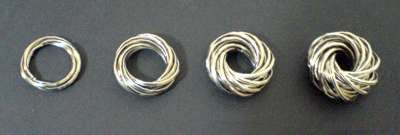 Computer graphics are fine, but the problem with programming a simulation of something is that often you only get out what you put in. You lose the element of surprise. So sometimes, if you you want to find out what something really does, you build one. Available technology and spare parts permitting, of course.
Computer graphics are fine, but the problem with programming a simulation of something is that often you only get out what you put in. You lose the element of surprise. So sometimes, if you you want to find out what something really does, you build one. Available technology and spare parts permitting, of course.For the "Villarceau Coil" blogpost, I figured that it was worth making a physical model. A good hardware place nearby sells middle-sized keyring loops for 15 pence each, so I went in with a few quid and came away with a pocketful. Then it was just a question of clipping the things together.
There were a couple of things that I hadn't expected:
Thing Number One was that a "keyring Villarceau coil" is a bit like a Slinky. You put it on the palm of your band, or on a flat surface, and tilt the surface, and the thing kinda ... slinks ... downhill. It reacts to the uneven pressure on its base, rings rotate and slither past each other, the torus squirms and turns inside out, and the thing scuttles off down the slope with a slightly guilty air about it, like an octopus running along a seabed.
From a science-fiction/xenobiology point of view, the coil makes an interesting template for a possible alien lifeform. With a soft toroidal body and a hard set of spiny Villarceau rings, an animal could burrow or shred predators or food by turning itself inside out. It could start as a skinny beastie with maybe three rings, and grow more rings as it got bigger and fatter. It'd solve the problem of how to reconcile a hard exoskeleton with the ability to change size. Young could be gestated as full-size rings within the fleshy body. Giving birth would probably have to be be kinda fatal, though, unless the rings each had a notch somewhere. :(
Anyhow ... Drop the coil, and it "splashes" when it lands, then reforms back to the torus shape ... or if you've used a lot of rings, into a pair of interlinked tori. You can pop it on your finger, and pass it from hand to hand, one finger at a time, by tilting your finger to point downhill towards the destination finger, so that the v-coil slinks down the finger, turning itself inside out as it goes.
So basically, a fun executive toy. Three quid well spent.

Thing Number Two was that the rings have a natural tendency to nest (as in, "what Russian Dolls do", not "what in birds do") .... except that, in this case, the self-similar "dolls" are all made from components that are exactly the same size. Which is a slightly wierd situation.
So if you start with maybe just three rings for a skinny torus, and you add more rings to force the thing to be fatter, you find yourself using a lot more rings than you thought. They start to form nesting toroidal layers. Since every torus that you can produce using the Villarceau configuration has exactly the same major radius as a single ring, they all fit neatly inside one another.
It's kinda reminiscent of the way that electron orbits stack up around an atomic nucleus.
And since every ring in the set of nested tori has exactly the same configuration to all the others, you can reach in and pull an inner ring and with a bit of shuggling turn it into an outer ring (while one of the outer rings shuffles back inward to take its place).
This is a FUN shape. You could probably write an entire book about it.




No comments:
Post a Comment